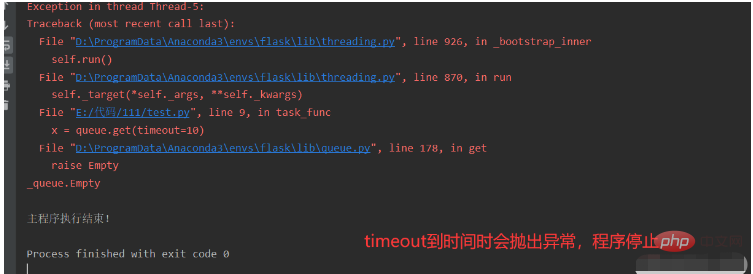Python 官方文档:入门教程 => 点击学习
python中使用到的队列模块大致有三个:1、from queue import Queue此模块适用于线程间通信,但不能用于进程间通信。示例代码1: 【注意:此时代码存在错误!!!】import time import threading
此模块适用于线程间通信,但不能用于进程间通信。
示例代码1: 【注意:此时代码存在错误!!!】
import time
import threading
from queue import Queue
def task_func():
global queue
while queue.qsize() > 0:
x = queue.get()
print(f"num: {x}")
time.sleep(0.1)
def producer_data():
global queue
for i in range(100):
queue.put(i)
time.sleep(0.1)
if __name__ == '__main__':
queue = Queue()
producer_thread = threading.Thread(target=producer_data)
producer_thread.start()
thread_list = []
for i in range(5):
thread = threading.Thread(target=task_func)
thread.start()
thread_list.append(thread)
for thread in thread_list:
thread.join()
print("主程序执行结束!")注意:上述写法:
while queue.qsize() > 0:
x = queue.get()当生产者速度没有消费者速度快时,上述消费者代码会提前结束,导致生产者的速度不能消费。
while True:
x = queue.get()这种写法也存在问题,此时消费者队列会一直监听生产者队列是否有数据,导致线程一直处于阻塞状态,程序会一直阻塞不会停止,严重浪费系统资源。如果使用apscheduler等定时任务的库的话,会导致定时任务无法启动。
其实queue队列中的put()或者get()方法中都提供了timeout参数,利用这个参数可以有效解决上述消除不能消费和线程一直阻塞问题。
示例代码2:
import time
import threading
from queue import Queue
def task_func():
global queue
while True:
x = queue.get(timeout=10)
print(f"num: {x}")
def producer_data():
global queue
for i in range(100):
queue.put(i)
time.sleep(0.1)
if __name__ == '__main__':
queue = Queue()
producer_thread = threading.Thread(target=producer_data)
producer_thread.start()
thread_list = []
for i in range(5):
thread = threading.Thread(target=task_func)
thread.start()
thread_list.append(thread)
for thread in thread_list:
thread.join()
print("主程序执行结束!")运行结果:

根据不同的情境,可以根据实际情况设置timeout的值。如果使用定时任务,使用timeout是可以的,不会使程序抛异常停止的。
此模块用于对进程,但是不能用于进程池
示例代码:
import time
from multiprocessing import Process, Queue
import queue
def producer(queue):
queue.put("a")
time.sleep(2)
def consumer(queue):
time.sleep(2)
data = queue.get()
print(data)
if __name__ == "__main__":
# queue = queue.Queue()
queue = Queue()
my_producer = Process(target=producer, args=(queue, ))
my_consumer = Process(target=consumer, args=(queue, ))
my_producer.start()
my_consumer.start()
my_producer.join()
my_consumer.join()
# 使用queue模块的Queue()会报错
# 使用multiprocessing中的Queue(),正确输出a运行结果:

示例代码:
import time
from multiprocessing import Process, Queue, Pool, Manager
def producer(queue):
queue.put("a")
time.sleep(2)
def consumer(queue):
time.sleep(2)
data = queue.get()
print(data)
if __name__ == "__main__":
# queue = Queue()
queue = Manager().Queue()
pool = Pool()
# pool中的进程间通信需要使用Manager
pool.apply_async(producer, args=(queue, ))
pool.apply_async(consumer, args=(queue, ))
pool.close()
pool.join()运行结果:

--结束END--
本文标题: Python队列的使用方法有哪些
本文链接: https://lsjlt.com/news/206167.html(转载时请注明来源链接)
有问题或投稿请发送至: 邮箱/279061341@qq.com QQ/279061341
2024-03-01
2024-03-01
2024-03-01
2024-02-29
2024-02-29
2024-02-29
2024-02-29
2024-02-29
2024-02-29
2024-02-29
回答
回答
回答
回答
回答
回答
回答
回答
回答
回答
0